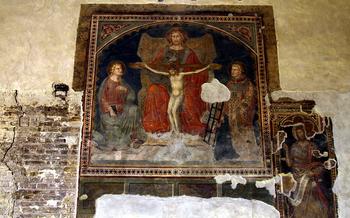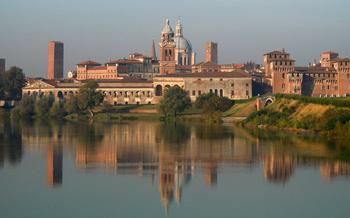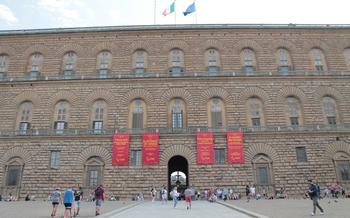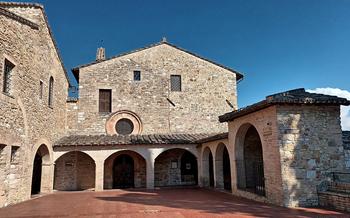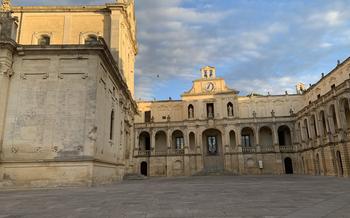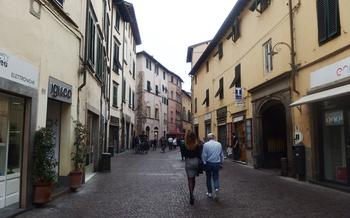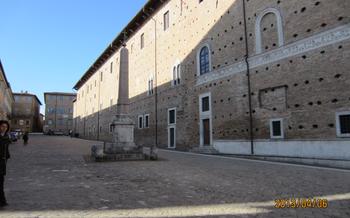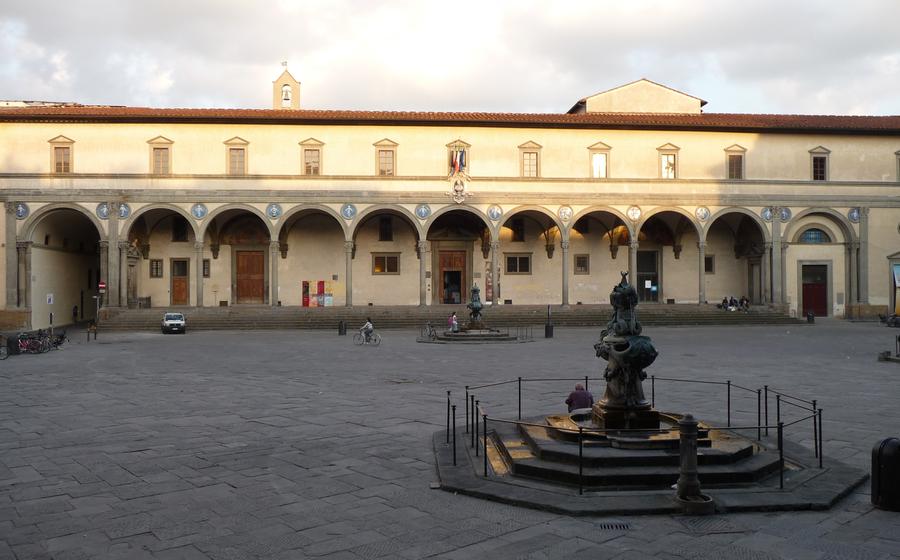
Ospedale degli Innocenti
- History
- Architecture
- Museo degli Innocenti
- Filippo Brunelleschi and the Innovative Use of Linear Perspective
- The Spedale di Santa Maria della Scala
- Other Notable Orphanages
- Abandoned Children in Renaissance Italy
- Wet Nurses
- Foundling Wheels
- Adoption
- Modern Orphanages
- Children's Rights
- Insider Tip
History
The Ospedale degli Innocenti was founded in 1419 by a wealthy silk merchant named Francesco Datini. It was established as a refuge for abandoned children and served as a model for similar institutions throughout Europe. The hospital was designed by Filippo Brunelleschi, one of the most influential architects of the Renaissance period. Brunelleschi's design was revolutionary for its time, featuring a harmonious blend of classical and modern elements. The hospital's arcaded portico, adorned with Luca della Robbia's glazed terracotta frieze depicting swaddled infants, is one of the most iconic examples of Renaissance architecture.
The Ospedale degli Innocenti functioned as an orphanage for over 500 years, caring for thousands of abandoned children. It was a place where orphans were given a safe haven, food, shelter, and education. The hospital also played a vital role in the development of modern pediatrics, as it was one of the first institutions to focus on the care of sick and abandoned children.
Architecture
The architectural significance of the Ospedale degli Innocenti lies in its harmonious proportions and innovative design, which reflects the principles of Renaissance architecture. The arcaded portico, a defining feature of the building, consists of nine arches supported by slender columns with Corinthian capitals. Above the portico, a terracotta frieze by Luca della Robbia depicts a procession of swaddled infants carried by angels, symbolizing the care and protection provided to the abandoned children. The frieze, with its delicate and expressive figures, is considered a masterpiece of Renaissance sculpture. The courtyard, with its elegant loggias and well-proportioned spaces, creates a sense of order and tranquility. The use of classical elements, such as columns, pilasters, and entablatures, reflects the revival of interest in ancient Roman architecture during the Renaissance. Overall, the Ospedale degli Innocenti stands as a testament to the architectural skill and vision of Filippo Brunelleschi, who created a building that is both functional and aesthetically pleasing.
Museo degli Innocenti
The Ospedale degli Innocenti is not only a magnificent architectural masterpiece but also home to the fascinating Museo degli Innocenti, which delves into the rich history of the institution and the lives of the children who were cared for within its walls. Through interactive exhibits, multimedia displays, and a collection of artifacts, the museum provides visitors with a unique glimpse into the daily life, challenges, and triumphs of the abandoned children who found refuge in this remarkable institution.
The museum's collections include artworks, documents, and personal belongings that offer poignant insights into the experiences of these children. Visitors can learn about the process of abandonment, the challenges faced by wet nurses, the role of foundling wheels, and the efforts made to ensure the well-being and future prospects of the children. The museum also sheds light on the evolving attitudes towards abandoned children and the changing social and economic factors that shaped their lives.
A visit to the Museo degli Innocenti is a deeply moving and educational experience that offers a deeper understanding of the complex issues surrounding abandoned children and the remarkable efforts made by the Ospedale degli Innocenti to provide them with a safe haven, care, and opportunities for a better life.
Filippo Brunelleschi and the Innovative Use of Linear Perspective
The Ospedale degli Innocenti stands as a testament to the genius of Filippo Brunelleschi, one of the most influential architects of the Renaissance. Brunelleschi, who is renowned for his pioneering work on linear perspective, employed this innovative technique in the design of the Ospedale, creating a harmonious and visually appealing composition. The use of linear perspective allowed Brunelleschi to create the illusion of depth and recession in the building's architecture, drawing the viewer's eye along the elegant lines of the arcades and towards the central vanishing point.
Brunelleschi's mastery of linear perspective not only enhanced the aesthetic appeal of the Ospedale degli Innocenti but also demonstrated his commitment to the principles of humanism and rationality. By applying the mathematical principles of perspective, Brunelleschi created a building that reflected the scientific and intellectual advancements of the Renaissance. The Ospedale degli Innocenti thus stands as a symbol of Brunelleschi's genius and his lasting contribution to the development of Renaissance architecture.
The Spedale di Santa Maria della Scala
The Spedale di Santa Maria della Scala in Siena is another remarkable historical hospital and orphanage in Tuscany. Founded in the 11th century, it served as a refuge for pilgrims, the sick, and abandoned children for over 800 years. Like the Ospedale degli Innocenti, the Spedale di Santa Maria della Scala is a testament to the spirit of charity and care for the less fortunate that was prevalent in Renaissance Italy.
The two institutions share several similarities. Both were initially run by religious orders and later came under the control of the city government. Both were designed to provide shelter, medical care, and education to abandoned children. Both also played a significant role in the development of healthcare and social welfare in Italy.
However, there are also some key differences between the two institutions. The Ospedale degli Innocenti was founded specifically for abandoned children, while the Spedale di Santa Maria della Scala also cared for the sick and the elderly. The Ospedale degli Innocenti is known for its iconic Loggia dei Innocenti, while the Spedale di Santa Maria della Scala is renowned for its vast complex of buildings and its collection of medieval and Renaissance art.
Despite their differences, the Ospedale degli Innocenti and the Spedale di Santa Maria della Scala are both important examples of the role that charitable institutions played in Renaissance Italy. They are a testament to the compassion and generosity of the people of Tuscany and to their commitment to caring for the most vulnerable members of society.
Other Notable Orphanages
The Ospedale degli Innocenti was not the only orphanage in Italy during the Renaissance period. Other notable institutions include the Ospedale dei Fatebenefratelli in Rome, founded in 1584, which provided care for abandoned children, the sick, and the elderly. The Istituto dei Figli della Provvidenza in Naples, established in the 17th century, was another prominent orphanage that played a crucial role in providing shelter, education, and vocational training to orphaned and abandoned children. These institutions, like the Ospedale degli Innocenti, made significant contributions to childcare and education, demonstrating the widespread commitment to caring for vulnerable children in Renaissance Italy.
Abandoned Children in Renaissance Italy
In Renaissance Italy, the phenomenon of abandoned children was widespread, due to a combination of social and economic factors. Poverty, war, and famine forced many families to abandon their children, often out of desperation or inability to provide for their basic needs. Social stigma associated with illegitimacy also contributed to the abandonment of infants, as unwed mothers faced discrimination and social rejection. Foundling wheels, devices used to anonymously abandon infants at orphanages, were introduced in response to the large number of abandoned children. These devices allowed mothers to leave their babies without revealing their identity, providing a measure of anonymity and secrecy. The high mortality rate among abandoned children, often due to malnutrition, disease, and neglect, was a tragic consequence of the harsh realities of life in Renaissance Italy.
Wet Nurses
Wet nurses played a crucial role in the care of abandoned children in Renaissance Italy. These women were hired to breastfeed and care for infants who had been abandoned at orphanages or foundling wheels. Wet nursing was a common practice in the era, as many mothers were unable or unwilling to nurse their own children due to factors such as illness, poverty, or social stigma.
Wet nurses came from a variety of backgrounds, including poor rural women, widows, and unmarried mothers. They often lived in the orphanages or foundling hospitals where they worked, and they were responsible for providing round-the-clock care for the infants in their charge.
Wet nursing was a challenging and demanding job. The women had to be healthy and well-nourished in order to provide adequate milk for the infants. They also had to be patient and compassionate, as they were caring for vulnerable and often traumatized children.
Despite the challenges, wet nurses were essential to the survival of abandoned children in Renaissance Italy. They provided the infants with the nourishment and nurturing they needed to grow and thrive. Without their dedication and care, many of these children would not have survived.
Foundling Wheels
Foundling wheels, also known as baby hatches or turning wheels, were devices used in orphanages to anonymously abandon infants. These cylindrical structures were typically made of wood or metal and had a rotating mechanism that allowed mothers to place their babies inside without being seen. The wheel would then be turned, concealing the infant and alerting the orphanage staff to its presence.
The use of foundling wheels dates back to the Middle Ages and was widespread in Europe until the 19th century. They were seen as a way to provide a safe and anonymous way for mothers to surrender their unwanted children, often due to poverty, illegitimacy, or social stigma.
Foundling wheels were often located at the entrance of orphanages or hospitals and were often decorated with religious iconography to encourage mothers to leave their children in the care of the institution. However, the use of foundling wheels was also controversial, as it allowed for the abandonment of infants without any accountability or traceability.
In Italy, foundling wheels were used in many orphanages, including the Ospedale degli Innocenti in Florence. The wheel at the Ospedale degli Innocenti was designed by Filippo Brunelleschi and is still visible today as a reminder of the institution's history.
The use of foundling wheels declined in the 19th century as adoption laws were reformed and social attitudes towards abandoned children changed. Today, foundling wheels are no longer used in Italy, and abandoned children are typically placed in the care of social services or adoption agencies.
Adoption
Adoption in Italy has a long and complex history, closely intertwined with the history of orphanages like the Ospedale degli Innocenti. In the past, adoption was often seen as a way to provide abandoned children with a family and a stable home. However, the legal framework for adoption was often lacking, and the rights of both the children and the adoptive parents were not always protected.
In the 20th century, there was a growing awareness of the importance of children's rights and the need for a more structured and transparent adoption process. This led to the enactment of several laws that aimed to regulate adoption and to ensure the best interests of the child.
Today, adoption in Italy is a well-established and regulated process. Prospective adoptive parents must undergo a rigorous evaluation process to ensure their suitability and ability to provide a loving and supportive home for a child. The adoption process is overseen by the Italian courts, which work to ensure that the rights of all parties involved are respected.
The Ospedale degli Innocenti, with its long history of caring for abandoned children, has played a significant role in the development of adoption in Italy. Through its adoption program, the Ospedale has helped countless children to find loving families and to build a better future for themselves.
Modern Orphanages
Modern orphanages in Italy have evolved significantly from their historical predecessors. In the past, orphanages were often seen as places of last resort, where abandoned children were sent to live in often harsh and unwelcoming conditions. However, today's orphanages are much more focused on providing a nurturing and supportive environment for children who are unable to live with their birth families.
Modern orphanages in Italy typically offer a range of services to support the children in their care, including education, healthcare, counseling, and job training. They also work to place children in adoptive or foster families whenever possible.
The Italian government plays a significant role in regulating and overseeing orphanages, ensuring that they meet high standards of care and that the rights of the children are protected. Italy is also a signatory to the United Nations Convention on the Rights of the Child, which sets out a number of important rights for children, including the right to a safe and nurturing environment, the right to education, and the right to be protected from abuse and neglect.
As a result of these changes, modern orphanages in Italy are now seen as important and valuable resources for children who are unable to live with their birth families. They provide a safe and supportive environment where children can learn, grow, and develop to their full potential.
Children's Rights
In modern Italy, children's rights are of paramount importance, and the country has a strong commitment to ensuring the well-being and protection of vulnerable children. The Italian Constitution guarantees various rights to children, including the right to education, healthcare, a family environment, and protection from all forms of violence and exploitation. The adoption process is strictly regulated to ensure the best interests of the child, and there is a strong emphasis on finding permanent and loving families for children in need.
Orphanages in Italy have evolved from historical institutions to modern childcare facilities, playing a crucial role in providing temporary care and support to children who cannot live with their biological families. These facilities are subject to rigorous regulations and are regularly monitored to ensure they meet the highest standards of care. The focus is on providing a nurturing and supportive environment that promotes the child's physical, emotional, and intellectual development.
For many orphans, these modern facilities provide a safe haven and a chance to thrive. They receive access to quality education, healthcare, and social services and are supported in developing their skills and talents. The goal is to help them reach their full potential and transition successfully into adulthood.
Italy's commitment to children's rights and the well-being of vulnerable children is reflected in its policies, regulations, and the tireless efforts of individuals and organizations dedicated to supporting those in need.
Insider Tip
For a truly immersive experience, plan your visit during the annual "Festa dell'Innocenza" (Feast of the Innocents), held in May. This vibrant festival brings the Ospedale degli Innocenti to life with historical reenactments, traditional music, and performances. Stroll through the enchanting cloisters, adorned with colorful decorations, and witness costumed actors portraying the hospital's staff and orphans from centuries past. Immerse yourself in the heartwarming traditions of the institution and gain a deeper appreciation for its enduring legacy.
